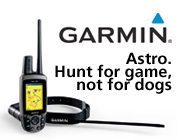




|
 |
Hunting Bassets - How to Train A Basset Hound To Hunt
Starting Your Basset Hound in the Field
Written by Peggy Sutton
 Now that you have chosen "the perfect pup," it's time to start his training as a field trial hound. When do you begin? Most people agree that you should wait until the puppy is about six months of age. Does this mean that you can't do any training before this age? No. Teaching him the simple commands of "come" and "down" will be a big help. So will breaking him into a collar and leash before your first trip to the field.
Will he be ready faster if you start earlier? Probably not. Dogs will always start at their own pace. Some will be ready at the age of six months, and others won't be ready until they are eighteen to twenty months of age. So don't give up on your puppy just because he isn't trailing game at a young age or as fast as another puppy.
Now that you have chosen "the perfect pup," it's time to start his training as a field trial hound. When do you begin? Most people agree that you should wait until the puppy is about six months of age. Does this mean that you can't do any training before this age? No. Teaching him the simple commands of "come" and "down" will be a big help. So will breaking him into a collar and leash before your first trip to the field.
Will he be ready faster if you start earlier? Probably not. Dogs will always start at their own pace. Some will be ready at the age of six months, and others won't be ready until they are eighteen to twenty months of age. So don't give up on your puppy just because he isn't trailing game at a young age or as fast as another puppy.
There are a few things to consider before we discuss taking your puppy out. Your pup should be in the best physical condition and have all his shots before the training begins. This is serious business and should be treated as such.
When pups first venture into the field everything is new to them, including the concept of hunting. They'll be more interested at first in playing in this new environment than in working. Don't get caught up in playing with them but also don't scold them. This will take time so have patience. Also, you will need to find a place where the rabbits are plentiful, unless you are one of those lucky few who have access to a starting pen.
There are many methods for starting your hound on trailing a rabbit. Following are some of the more common ones. Are they guaranteed to work? No. Will one work all the time? Probably not. Just like people, each hound is slightly different and sometimes you will need to try a new approach, or several different ones.
 The most common method is to take a pup or puppies to the field and walk very slowly, allowing them to smell around. Try to allow the pup to smell an area where a rabbit has been sitting (called a squat). This area tends to have the strongest smell. If you get no response from the pup, try to work him up the line where the rabbit ran. Make sure you get a marked line for every rabbit, don't guess. Most likely the puppy will think this is a new game and he may not understand what you want him to do. This is where you will need all your patience. If you get no response on the first rabbit resume walking slowly until you find another rabbit. The pup may show interest in smelling an area where you have not seen a rabbit; just stand quietly while he smells around.
The most common method is to take a pup or puppies to the field and walk very slowly, allowing them to smell around. Try to allow the pup to smell an area where a rabbit has been sitting (called a squat). This area tends to have the strongest smell. If you get no response from the pup, try to work him up the line where the rabbit ran. Make sure you get a marked line for every rabbit, don't guess. Most likely the puppy will think this is a new game and he may not understand what you want him to do. This is where you will need all your patience. If you get no response on the first rabbit resume walking slowly until you find another rabbit. The pup may show interest in smelling an area where you have not seen a rabbit; just stand quietly while he smells around.
A second common method is to obtain a freshly killed rabbit. The one problem with this method is that you would have to be lucky. You would either have to be training your hound during hunting season or find a road kill along the side of the road, though the rabbit should not resemble pizza. The freshly killed rabbit would then be used as a drag. This allows you to form a line for the pup to follow. The drag method has the advantage of being able to work in your own yard with the pup for a few days, knowing exactly where the line is. You would then be able to use one of these rabbits for about three days.
 A different kind of technique used by some owners is a rolling cage. This is an adaptation of an idea used by coon hunters. A tame rabbit is placed in a cage shaped like a wheel. The pups are then allowed to get up close to the rabbit and smell it all they want. It provides protection for both the rabbit and the younger pups. I have seen tame rabbits kick a young pup causing the hound to back away or become afraid of the rabbit. In this way the pups are safe to chase the rabbit when the cage is rolled around. The pups are also provided with a line to follow. Does this method work? Several members of my family have used this technique with good success. Is this the only method we use? No. We then take them to the field and expose them to regular scent lines and proceed from there. This method tends to help establish the idea of what we want from them when we first head to the field.
A different kind of technique used by some owners is a rolling cage. This is an adaptation of an idea used by coon hunters. A tame rabbit is placed in a cage shaped like a wheel. The pups are then allowed to get up close to the rabbit and smell it all they want. It provides protection for both the rabbit and the younger pups. I have seen tame rabbits kick a young pup causing the hound to back away or become afraid of the rabbit. In this way the pups are safe to chase the rabbit when the cage is rolled around. The pups are also provided with a line to follow. Does this method work? Several members of my family have used this technique with good success. Is this the only method we use? No. We then take them to the field and expose them to regular scent lines and proceed from there. This method tends to help establish the idea of what we want from them when we first head to the field.
There are a few other methods that I would like to discuss. One method is to let the pup start by himself. Basically you take the hound to a fenced-in area that has a plentiful supply of rabbits, such as a "starting pen." In the course of time he will start himself. Two undesirable aspects of this method is that your hound will not see hunting as a sport you do together, and second, you will miss the first time he lays claim to a line. However, you can personally take him to the starting pen. Seeing the rabbit can help some hounds start, but it can also hurt some because they may persevere in "sight chasing" instead of tracking by scent. This is a habit that can be difficult to break.
If your pup can learn from imitation, then this second method may be good for him. Let him run with another hound with good qualities including habits and style. The one hazard of this method is that the hounds will become too dependent, especially on the good hound. He will need to learn to run independently and also that not all hounds are necessarily reliable.
The last method I wish to talk about is that of letting a young pup start with a pack of other hounds. This is similar to the above method except the hound is running with dogs of a variety of styles and abilities. With this style of training he will have less of a chance for becoming dependent on any one hound. However, there is a greater chance of him becoming careless and developing too much speed before careful trailing is learned. The pup should probably be run separately from the pack once he has started.
 Choosing the method to use on your pup will depend on your particular dog and what types of running you are preparing him for. It may take more than one method and could take several different ones. The training of a pup can take a long time and you may feel at times he will never get started. Then one day the light bulb goes off above his head and he will realize he was born to run bunnies. The time and aggravation will all be worth it when he first barks on the line. Just remember, hunting is a JOY for both you and your hound to do together. Don't be harsh and don't force him to start early or you run the risk of breaking his spirit. Now is the time to start dreaming of all your hound's first places and champion points. Good luck--and hope to see you at the field trials!
Choosing the method to use on your pup will depend on your particular dog and what types of running you are preparing him for. It may take more than one method and could take several different ones. The training of a pup can take a long time and you may feel at times he will never get started. Then one day the light bulb goes off above his head and he will realize he was born to run bunnies. The time and aggravation will all be worth it when he first barks on the line. Just remember, hunting is a JOY for both you and your hound to do together. Don't be harsh and don't force him to start early or you run the risk of breaking his spirit. Now is the time to start dreaming of all your hound's first places and champion points. Good luck--and hope to see you at the field trials!
Published Tally-Ho: September/October 1997
USED BY PERMISSION
Back to Top of Page
|

